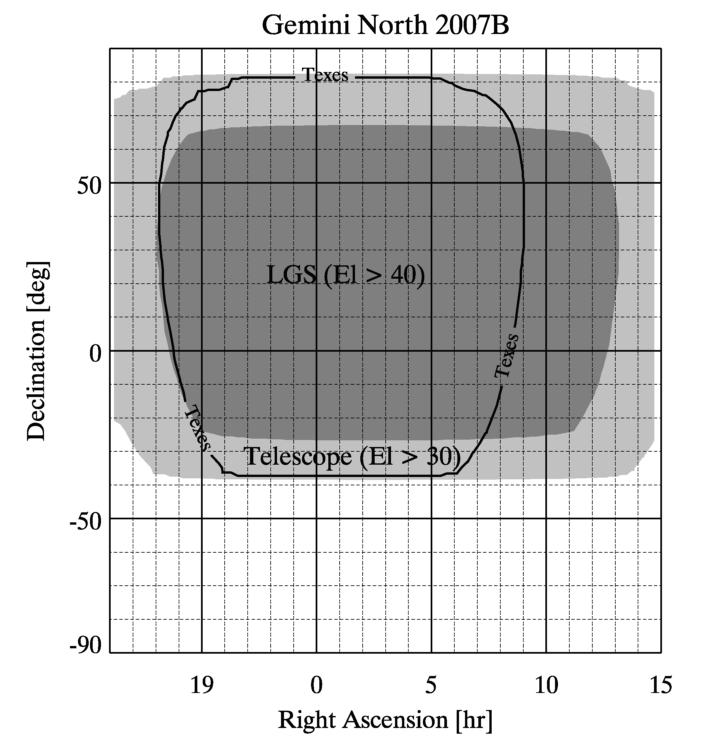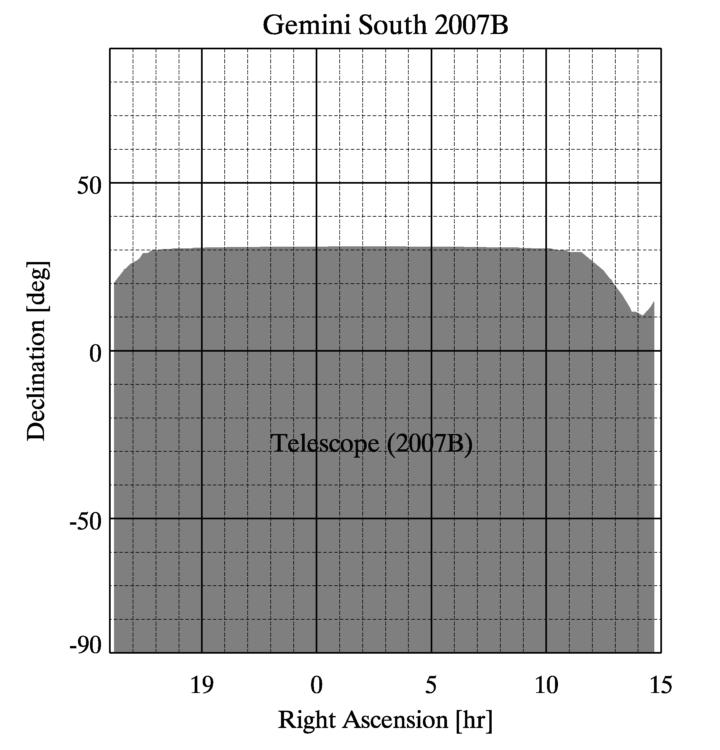Instrument Availability and Target Accessibility: 2007B
You are here
Instrument Availability and Target Accessibility: 2007B
This page provides best estimates, at the time of the Call for Proposals, of instrument availability and corresponding target (RA, dec) restrictions for 2007B.
General
Instrument Changes: As there are more instruments than the number of available ports on each telescope, instrument swaps will be required. Therefore not all instruments will be available for the entire semester. However, whenever possible instrument swaps will be scheduled to minimize impact on the queue. In other words, instrument swaps will be driven by demand as much as possible and so the final schedule will not be made until after the 2007B programs are known. Nevertheless, it may be the case that certain targets or entire programs will not be feasible once the final schedule is determined, at ITAC or thereafter. This is especially true at Gemini South, where a significant fraction of the schedule is reserved for new instrument commissioning.
No instrument changes are permitted during classical runs.
Gemini North
At Gemini North, NIFS and Michelle share the up-looking port. It is expected that Michelle will be mounted at the start of the semester, NIFS will occupy the middle of the semester and Michelle will be re-mounted near the end. The exact dates of these swaps will be driven largely by consideration of the targets in the queue, and so there are no special restrictions on target availability for either instrument.
The visitor instrument TEXES will have a single observing run during the month of October. Targets to be observed with TEXES must be observable during this time. The allowed RA and DEC ranges are shown by the solid black line in the figure below.
Observations requiring the Laser Guide Star (LGS) system are restricted by the limitation that the LGS must be used at or above 40 degrees elevation. How this translates into RA and dec restrictions is indicated in the figure below.
In addition, because of the requirement to obtain advance approval of all telescope pointings, it is not possible to use LGS with Rapid Response Target of Opportunity observations. Standard ToO LGS observations are allowed; however, targets must be defined at least 8 days in advance of the start of the LGS observing block in which the observations are desired.
Figure 1 displays the accessibility of targets as a function of RA (horizontal axis) and Declination (vertical axis) at Gemini North for the 2007B semester. The dark gray area indicates the restriction on LGS observations, and the solid black line encircles the coordinates available for TEXES observations. The larger light gray area indicates sky positions that are above 2.5 airmasses for at least 2 hours on at least 7 days of the semester. Targets outside this area should not be requested in 2007B. However, these represent the minimum criteria for scheduling an observation in the queue (or classically), and proposers with targets very close to the extremes are advised to consider carefully other factors such as the amount of time needed on the source, the observing conditions required and the likely weather at the time, and the maximum airmass acceptable for the observation.

Figure 1: Target accessibility at Gemini North during semester 2007B.
Gemini South
At Gemini South, 25% of the semester is reserved for engineering, including new instrument commissioning (both NICI and Flamingos-2) and the start of multi-conjugate adaptive optics (MCAO) commissioning. NICI will share the up-looking port with T-ReCS and Flamingos-2 will share a side port with GMOS-S. As of this writing, it is not known when the instrument swaps will occur, although every effort will be made to accomodate the queue, particularly Band 1 & 2 programs. Programs requesting GMOS-S or T-ReCS that can specify targets covering a range in R.A. are encouraged to do so. However, given the uncertainty of new instrument commissioning schedules, no special target restrictions are being placed on any Gemini South instruments in 2007B.
Figure 2 displays the accessibility of targets as a function of RA (horizontal axis) and Declination (vertical axis) at Gemini South for the 2007B semester. The large gray area indicates sky positions above airmass 2.5 for at least 2 hours on at least 7 days during the semester. Targets outside this area should not be requested in 2007B. However, these represent the minimum criteria for scheduling an observation in the queue (or classically), and proposers with targets very close to the extremes are advised to consider carefully other factors such as the amount of time needed on the source, the observing conditions required and the likely weather at the time, and the maximum airmass acceptable for the observation.

Figure 2: Target accessibility at Gemini South during semester 2007B.
Last update 27 February, 2007; Bernadette Rodgers
